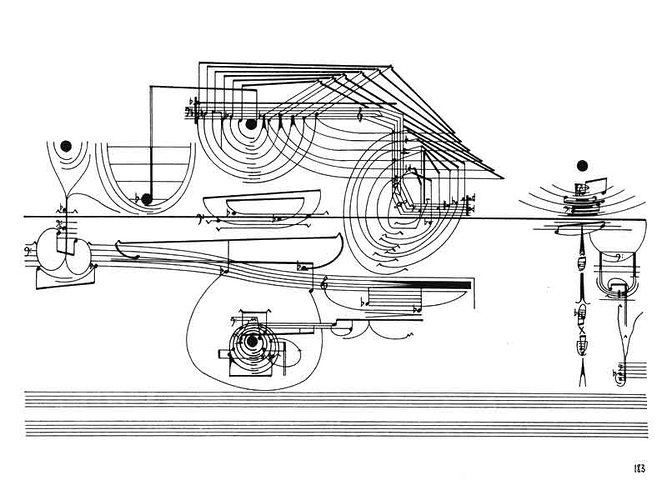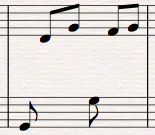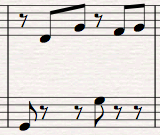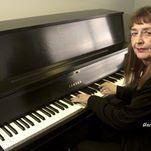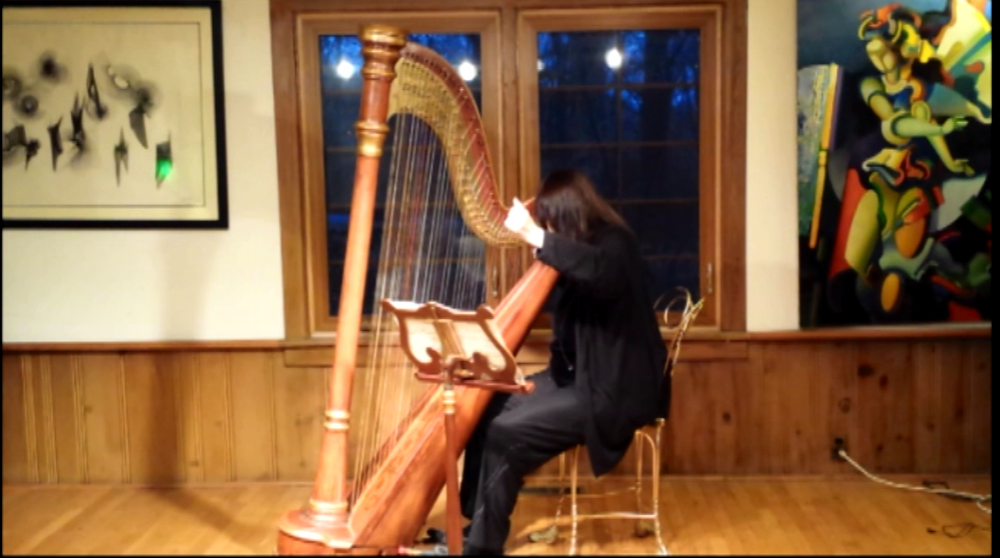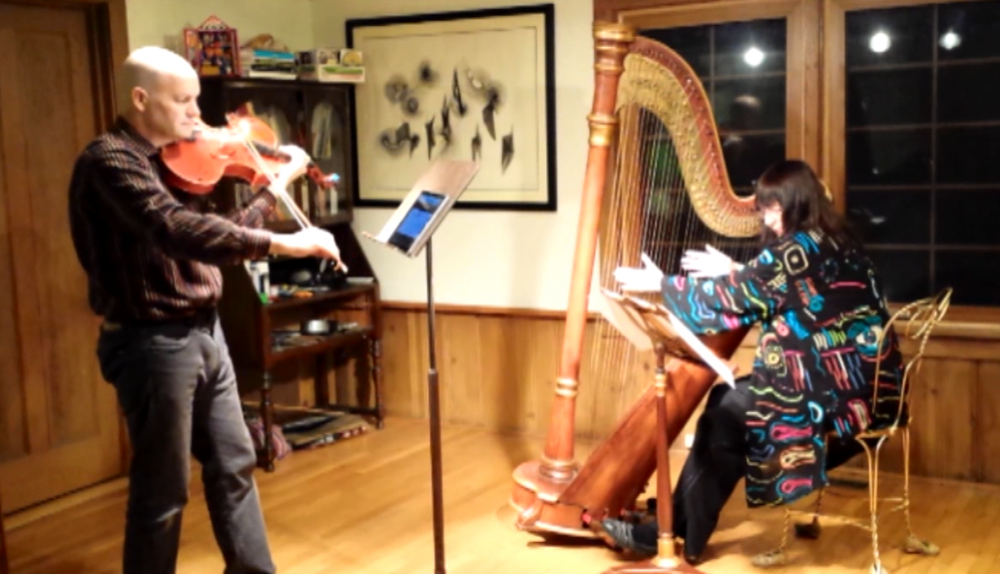Search the Community
Showing results for tags 'notation'.
-
I did 't know where to post this.... Well, that's the question: Dorico by Steingberg. I downloaded the trial version, which is full functional for a month. I was determined to work a bit with it, and I watched several tutorials on youtube. At first, it was a mess because the shortcuts are different depending on the language you select. So, many things the tutorials said are useless in Spanish, Portuguese, or French. I think Dorico needs to improve a lot, or incorporate lacking functions at the moment. However, I'm impressed how quickly I could write a score (in 1 day). And some things that are a nightmare in Finale, in Dorico are easy: non standard key signatures, complex tuplets and similar, chord notation, ... And one important issue: Finale manage very badly audio export. I've been using Finale for some years and from Finale 14 version the audio sounds with noises, clics, scratches and everything. I costs a los to get a clean audio. This is something that happens to many people (I read it in the Makemusic forum), but no solución has been given. With Dorico, this problem has dissappeared. Now I'm in "standby". My iMac has "died" after 8 years... Fixing it would cost a lot. So I'm waiting for a new one. But I am considering a change to Dórico, since I could buy it with cross-grade + educacional discount....
-
Hello, I am really interested in composing graphic notation music, so I searched on the internet for a free notation software that has been designed for this purpose. Unfortunately, I could not find anything. Do you know a graphic notation programm? If so, what is the name and where can I find it? Thanks! Maarten For example:
-
Hey there, had a quick notational question: I noticed that some composer put beams over rests, like the image I attached. Is this a useful/preferred technique, or is it completely personal preference to the composer? Thanks a lot!
-
In regards to what is more comfortable to read, I have been struggling between 2 ways of notating the same 6/8 rhythm. using ties not using ties Which, out of the 2 bars above, is the preferred way to notate such rhythms for the sake of simplicity and quick understanding by the musician being asked to read? --------------------------------------------------------------------------- Also, when writing out a part for a harpist, I read that it is customary to forego writing out the rests unless an intended rest is actually to be played (i.e. the harp is a naturally legato instrument). Out of the two bars below, and with respect to how a harpist would like to see the notation, is either one better than the other? The music outlined by the written bars here is, in fact, legato (no rests), however, I didn't want to break the reading musician's ability to count into a measure using any visible rests (especially for more complicated bars of music than pictured here). rests no rests
-
HARPINATIONS: recent release by ArpaViva of 4 harp compositions composed and performed by Shirley Meyer Blankenship: Metaphysical Waltz, Peace for Guidosan and two works for viola and harp: Fantasy I and Fantasy II with Rudolf Haken, violist.
- 1 reply
-
- harp
- compostion
-
(and 2 more)
Tagged with:
-
EDIT: This survey is now closed, thanks to all who took part. I may publish the results in February, and if so, I will add a link here later. Hi folks - first post, so apologies to the mods if this type of post is not allowed! I am a composition student at the University of Surrey and I am throwing around a survey across the internet to gather some data on how musicians write music with music notation software - this forum seemed very lively, so I'm very interested in your thoughts. If you are someone that composes/arranges music with music notation software (Sibelius/Finale/MuseScore/etc.) I would be extremely grateful if you could spare 10 minutes to fill out this survey: https://freeonlinesurveys.com/s/eZTxmoaK At the end, there will be two participants chosen in a random raffle that will receive £15 via PayPal. The survey will close in 7 days (6th January 2018). If you have any questions/comments/discussion - fire away! Thank you and have a Happy New Year!
-
- composition
- composing
-
(and 5 more)
Tagged with:
-
Hi all, After my secondary school I want to study either Classical Saxophone or Composition. When I am chatting with Composition professors, it seems to me that they prefer composing on paper and then they notate in a notation program. I have tried it several times to compose on paper, but I find it really hard. Not because I don't know what the music will really sound like, but because I make so many notation mistakes. Actually, when writing music on paper, my scores look like Beethoven's (see picture) and I cannot even read in myself. . . My question: ''Do you compose your music first on paper and then in a notation program? Or do you directly notate in a program, such as Sibelius or MuseScore? Why?'' I think the ''Why'' is the most important part of the question. Please let me know your opinions, experiences etc. Kind regards, Maarten
-
Hi all, After my secondary school I want to study either Classical Saxophone or Composition. When I am chatting with Composition professors, it seems to me that they prefer composing on paper and then they notate in a notation program. I have tried it several times to compose on paper, but I find it really hard. Not because I don't know what the music will really sound like, but because I make so many notation mistakes. Actually, when writing music on paper, my scores look like Beethoven's (see picture) and I cannot even read in myself. . . My question: ''Do you compose your music first on paper and then in a notation program? Or do you directly notate in a program, such as Sibelius or MuseScore? Why?'' I think the ''Why'' is the most important part of the question. Please let me know your opinions, experiences etc. Answering the poll would be very nice. Kind regards, Maarten
-
I'm sure that most of you know that writing out music is very time consuming, whether you're spending 20 minutes on drawing your staff neatly for your notes to sit on, or constantly erasing notes on Finale because your mouse slipped by a centimeter and placed a Snare Drum buzz roll instead of a rim shot. Over the years of composing marching percussion music, I've developed another method of composing music that may prove useful to composers with limited time. Because this is so different in comparison to the notation that has always been used throughout the history of music, this probably won't gain any popularity at all among percussion composers. But I guess this is worth a shot, since it works for me, and might work for you. So let me begin presenting to you what I call the "Alphabet Notation" for rhythm or percussion. This is what one measure of rest looks like: / [ . . . . ] [ . . . . ] [ . . . . ] [ . . . . ] / / = measure bar [] = one count . = 16th subdivision of a measure A note's value is determined by the number of "." subdivisions that follow it (A 1/16th note having no following subdivisions, an 1/8th note having one following subdivision, and a 1/4 note having 3). Keep in mind that one count can fit four 16th notes in it. The classic "Eights" warm-up would look like this: TD (4/4) / [ 1 . 1 . ] [ 1 . 1 . ] [ 1 . 1 . ] [ 1 . 1 . ] / [ 2 . 2 . ] [ 2 . 2 . ] [ 2 . 2 . ] [ 2 . 2 . ] / And so on... BD (4/4) / [ 1 . 1 . ] [ 1 . 1 . ] [ 1 . 1 . ] [ 1 . 1 . ] / [ 2 . 2 . ] [ 2 . 2 . ] [ 2 . 2 . ] [ 2 . 2 . ] / And so on... SD (4/4) / [ R . R . ] [ R . R . ] [ R . R . ] [ R . R . ] / [ L . L . ] [ L . L . ] [ L . L . ] [ L . L . ] / And so on... For tenor and bassline, notes are represented by numbers corresponding to drum size. s = Spock Drum 1 S = Spock Drum 2 5 = Bass 5 X = rimshot x = stick click r = on the rim For snareline: R/L = right or left hand for each note Rr/Ll = flam notes Rz/Lz = buzzed notes X = rimshot x = stick click r = on the rim Tremolo is tricky, but hear me out. As most of you know, a tremolo line divides the notes value by two and fills the original value with notes of the new value. (A 1/4 note with a tremolo sounds like two eight notes; an 1/8th note with a tremolo sounds like two 16th notes.) In alphabet notation, consider this and maintain the count's value of four 16th subdivisions. When adding tremolo lines in this notation, you need to cancel out the subdivisions that the sound of the tremolo note goes over in that count. For example: (4/4) / [ R . L . ] [ R . L . ] [ R, L, ] [ R, L, ] // The first two counts are normal. But on counts three and four, you can see that I didn't include the second and fourth subdivisions on that count. That's because with the "," tremolo line, the eight note's value doubles into the next subdivision. Applying this concept may become increasingly difficult with drags on 16th notes, thus creating 32nd notes. To put it somewhat simple, you eliminate the "." subdivision that is played over with the preceding tremolo note. Two tremolo lines indicate a double stroke roll, which is basically 32nd notes filling the value of the original note. When placing two tremolo lines on a "[ R . . . ]" quarter note, you would write [ R,, ] since the entire count is played through, leaving no room for "." subdivisions. When placing two tremolo lines on "[ R . R .]" one of two 1/8th notes, you would write [R,, R . ] since the roll fills the 1/8th note value, leaving no room for the subdivision after the "R." Moving on, triplet figures indicated by underlining. For example, (4/4) / [ R L R L R L ] [ R . R L L ] [[ R Rl Rl ]] / [ R L R ] [ L R L ] [ R . . . ] [ R L L ] / [ R . . . ] [ . . . . ] [ . . . . ] [ . . . . ] // **Envision the bracket topped with a "3" that indicates a triplet figure in traditional notation.** The first count in the first measure presents a sextuplet figure, while the second count presents an regular 1/8th note followed by a triplet figure of 1/8th notes. For figures that last more than one count, you can combine the count brackets like I did in the first measure. It presents a triplet figure of quarter notes in the third and fourth counts. And in the second measure, the first, second and fourth counts present 1/8th note triplet figures, with a regular quarter note on the third count. Time signature in boldface preceding the first measure. Dynamics can be placed before the count in which it should be expressed in italics or cursive. Crescendos/Decrescendos between counts. For example: TD (4/4) / f [ 1 . 2 2 ] [ 3 . 4 . ] [ 3, 2, ] [ 1, S . ] / [ 1 1 1, ] > [ 2 2 2, ] > [ 3 3 3, ] > [ 4 4 4, ] > / p [ 4 . 4 4 ] [ . 4 4 . ] [ 4 . . . ] [ . . . . ] // >/< = crescendo or decrescendo And Accents indicated by bold faced notes. I'm sure most of you understand that one count consists of 4 16th subdivisions. That's basically what this notation is based on. There are no rests, you're pretty much looking at the subdivisions for each count and plugging in the notes from there. I believe this can make music translatable through keyboard without needing a special program. And when writing music by hand, this can safe the time-consuming preparations, like drawing the 5-line staff. And this is new, so of course, there's tons of room for evolution if Alphabet Notation turns out useful to anyone else.
- 6 replies
-
- 1
-

-
- percussion
- composition
-
(and 4 more)
Tagged with:
-
Question 1 (fermata): Which one do you prefer? (in case you're wondering, 2 is correct: the 3/4 meter is just implied) My main concern is if this use of the fermata is correct, since we know that generally it is used when a section of the piece ends (and the performer kind of takes a breath), or when the piece itself ends (final chords taking how long you want, for emphasis). Question 2 (acciaccatura): Knowing that the correct way to notate a slur is: how do you notate an acciaccatura?
-
I've been working on an opera project with some colleagues for a long while, and some of it requires custom notation. After much discussion, we’ve come up with notation for chromatic/atonal mordents pictured above. These would completely replace the classical mordents we know from the Baroque, since frequent use has made it necessary to always specify the interval at which the ornament is. I would like to know what you think of these, if they seem sensible and functional to you, or not. For vote-counting convenience, please VOTE HERE. If you vote no, please also explain why in a comment. Thank you.
-
"Sempre" means "always". So "sempre staccato" means that you have to play staccato the entire part/section. But in italian it also means "again", "still", "even now". My question is, can "sempre" be used as a reminder? For example, a section is "più mosso". After let's say two pages, to make clear to the performer that he/she shouldn't slow down, can I write "sempre più mosso"? With the intention of saying "you still have to play più mosso!". Or will it be interpreted as "from now on, play even more fast"? Or will it be interpreted as "keep going more and more fast"? Since "sempre più" also exists and have a different meaning.
-
Are there any conventional style rules for how to divide up a rest for best read-ability? For instance, if I'm in 6/8 time, and a part has a 1/16 pickup note to a measure, how would you choose to write the rest before the 1/16 note? A dotted quarter rest, followed by a quarter rest, followed by a sixteenth rest? (To help them see the relation between their rhythm and the greater pulse of the piece at a glance). Or a half rest followed by a dotted eighth? (Because it just keeps the page cleaner.) A dotted quarter rest, followed by an eighth, followed by a dotted eighth? Does anyone else think about these things, or is it just me? Generally, the trickier the rhythm, the more likely I am to write it in a way that nicely subdivides the beats so that you can't help but count it correctly. Since we all tend to fall asleep and stop counting on the rests. Particularly long rests. And I tend to put it in relation to another rhythm in another part on the page. So if while you are resting, someone else's part goes quarter note, dotted eighth, I'll write your rest as quarter note, dotted eighth so the relationship is clear, and you know you can just listen to them, and then come in. But if their part goes dotted eighth, quarter, I'll write yours as dotted eighth, quarter. But if it's a situation where the conductor will have a hand free to give you a big fat cue, maybe it's tidier to just write rests in as long of values as possible as opposed to subdividing. Are there actually conventions for this? There are for everything else… But I've never seen this addressed in a style guide.
-
Hello one and all. I recently had a school I worked at ask me to write a piece for their middle school band. I'll be honest and confess it has been a very very long time since I reviewed percussion notation (I've been teaching LA not music) and was wondering if anyone had any advice about writing percussion lines for beginners? The students I am writing for will only have been playing for about 1-2 years. I emailed the band director to see how many percussionists she will have for the coming school year but as of yet haven't gotten any information back. My guess is about 6 based on last year's numbers and unless they practiced A LOT over the summer they play about as well as you would expect kids with 2 years of experience to play. I know more complex pieces have multiple instruments per page so individuals assigned more than one instrument can function better but I wanted to know are there any special notation standards for beginners? Are there instruments, rhythms, or techniques that I should be avoiding? I don't want to be torturing these poor kids to the point they want to quit nor do I want to give them parts riddled with mistakes. I would also like for there to be some educational value to what I am asking them to do, but as a cellist I don't really know what the standard progression of 'difficult stuff' for percussionists should be. So basically, any and all advice on beginner percussionists would be most welcome. Thanks in advance to everyone!
- 2 replies
-
- percussion
- music students
-
(and 1 more)
Tagged with:
-
Hi ppl! I am looking for a composition-software. I know programms which only allow you to type in notes in a notation view but I also need a piano-roll (like the one in Fruity-Loops or Logic, Garage-Band, etc..). It is also very important that I can integrate VSTs like "The Grand 3" or "Alicia's keys" because I hate that typical bad-quality-sound which programms like "Sibelius" have. I don't need any programms like "FL Studio" or "Logic" because I never use and don't want to pay for all of the functions beside the piano roll and vst-integration. regards alex2east :)
-
- composing
- piano roll
-
(and 4 more)
Tagged with:
-
Hey all, I am trying to find a method to notate key velocities of notes in my finale files. These scores were made from midi files composed and exported from my daw. The velocity data cannot be expressed with automated standard dynamic markings as I mean to express the volume of every individual note (rather than the intensity of a phrase.) I will need to use a kind of non-standardized notation according to velocity value, just as notes are arranged on the staff according to midi note number, Anything but colored note heads and manually drawing graphics in illustrator as I've had to do in the past.. I'm happy to buy any software needed. I have not been able to try Audio Impressions' Notation Switchblade yet because it does not run on osx 10.9, (not sure if this program contains my solution anyway), but I've tried a lot else. Logic DP live Sibelius musescore cubase etc etc.. Ideas? Programmers, come out! Thanks!
-
I mostly compose directly in software. One of the things I find is hard during the composition process is pressing the delete key when something isn't working quite right. I don't want to lose some fragment that I might want later on, but on the other hand, I don't want to keep it around cluttering up the score at the moment either. As a software developer, at work we use a "version control" system to keep track of changing source files. I was wondering if anyone who composes in a notation program has tried using a similar system to keep track of revisions to a work-in-progress. I'm considering trying it out myself. (For any other programmers, I'm thinking of a tool like subversion or git. I'm not sure how diffs would work, though)
- 3 replies
-
- notation
- version control
-
(and 1 more)
Tagged with:
-
http://opinionator.b...lines/?emc=eta1 Go ahead and read that. I think it would make an interesting discussion. The article discusses non-standard notation and its effectiveness in the long run. :)



